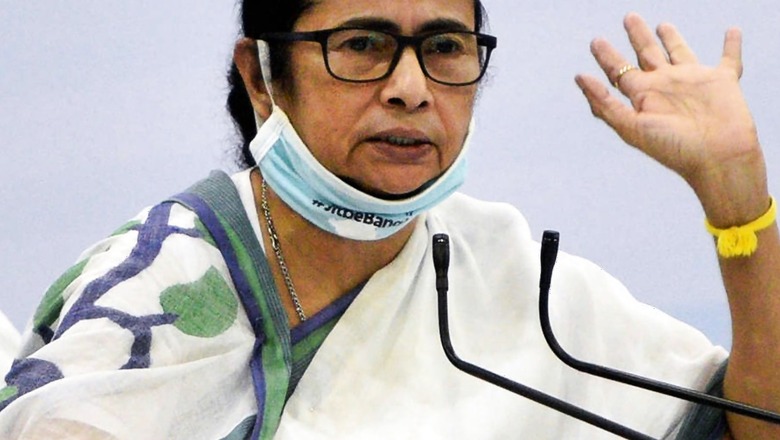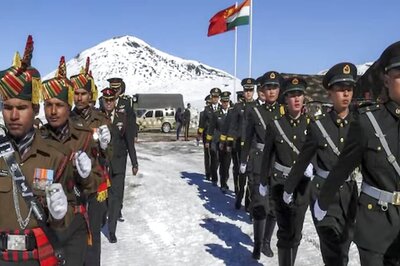
views
On October 9, Hindu households were ransacked, vehicles razed, and shops torched by the so-called oppressed Muslim minority in Mominpur, Dompara, and areas of West Bengal’s Ekbalpur, Kolkata over desecration of their flag. However, these anti-social elements proclaiming jihad on Hindus pressed the blame on Hindus, who were at the receiving end of the animosity.
As per reports, Mishri Lal Dhanuk, a resident of Mominpur and Secretary of the Harijan Durgosave Committee, said the local Muslims had put up a flag in the middle of the road ahead of the Eid-Milad-Un-Nabi celebrations. “A total of 42 bikes and four taxis were damaged. All of us in the neighbourhood were on our feet. The Islamists were about to enter the puja pandal, but their plan was thwarted by the arrival of the police. This, however, did not preclude the Islamists from perpetuating their bout of mayhem,” he said.
Consequently, the West Bengal Police imposed section 144 for two days in the Ekbalpur region of the state for two days starting October 10.
Also, West Bengal Bharatiya Janata Party (BJP) president Sukanta Majumder was stopped by police on his way to the area on Monday morning to ensure the plight of Hindus receives no media attention and that no proof of violence or its destruction gets documented. The BJP leader was detained in the central lock-up at Lalbazar. Leader of Opposition Suvendu Adhikari also registered a protest and brought the matter to national attention. Nabendu Kumar Bandyopadhyay and Niladri Saha approached the Calcutta High Court. The court allowed the two to file their petition on the 12th. The petitioners were represented by Swatarup Banerjee, Lokenath Chatterjee, and others, while the state was represented by AGP T.M. Siddiqui; the CBI was represented by DSG Billwadal Bhattacharya, and the CESC was represented by Advocate Kaushik Gupta. The Calcutta High Court has ordered the Director General of Police for West Bengal and the Commissioner of Police for Kolkata to assign a Special Investigation Team (SIT) to investigate the violence. Now, the Central government will decide whether or not to let the National Investigation Agency (NIA) do the investigation.
Sadly, this is the normal state of affairs in West Bengal. For over a century, the saga of the Islamic hordes running amok, tormenting the Hindus and, hence, threating the national interests and secular fabric, is indeed harrowing. This has been the sine qua non of Bengal since 1905, a watershed in the history of Bharat. Let’s roll back to 1905 when (united) Bengal was the largest province of India with over 80 million people; it amassed the present-day Bangladesh, West Bengal, Assam, Odisha, Bihar, and Jharkhand. Then took place the “first vivisection of our motherland”.
In his telling work, Partitioned Freedom, Ram Madhav quotes an article from an erstwhile prominent Muslim magazine of Culcutta (now Kolkata), dated September 22, 1905: “The Muhammedan community should be thankful to the British Government for the benefits that the Partition will confer on it”.
“The Congress, then led by Surendranath Banerjee in Bengal and the entire Hindu population, staunchly opposed the partition of Bengal. Muslims under the leadership of Nawab Salimullah of Dacca, on the other hand, welcomed it. East Bengal and Assam—the proposed Muslim-majority provinces—suited the interests of the Muslim upper class greatly. They became the majority there, and Assam became their playground. Hindus, on the other hand, started the Swadeshi movement,” noted retired IAS officer Sanjay Dixit in his seminal book, Unbreaking India: Decisions on Article 370 and the CAA.
On December 30, 1906, Nawab Salimullah recommended the formation of a separate political party for Muslims, following which the All India Muslim League was formed, albeit the inception of this very idea is ascribed to Sir Syed Ahmad Khan’s Aligarh Movement. However, its insistence on treating Muslims as a separate class based on imagined and false phobias and concocted narratives received a warm welcome from the British. The Morley-Minto Reforms of 1909 were quickly followed by the inclusion of the Indian Councils Act, 1909, by the British Parliament, in which the British proposed separate electorates for the general classes and Muslims, which marks the genesis of “special treatment for Muslims”.
When we look at the reasons for separate electorates, we find that they are mainly ludicrous at worst and specious at best. These are the types of arguments that have become commonplace. These disputes persisted during the Khilafat Movement, the Round Table Conferences, the 1937 elections, the Pirpur Report, the Cripps Mission, the Cabinet Mission, and the Partition Movement, and they continue to this day. Muslims have remained aggressors while brilliantly playing the victim. Sita Ram Goel wrote in his riveting book, Muslim Separatism—Causes and Consequences (1995), quoting H.V. Seshadri: “To begin, we’d like to focus on what we believe to be its most important contribution: the unraveling of two behavior patterns—Muslim and National—that had been working together for years and precipitated Partition in the final round. Acrimony, accusations, complaints, demands, denunciations, and street riots characterized Muslim behavior. Acquiescence, assent, cajolery, concessions, timidity, self-reproach, and submission characterized the national behavior pattern”.
In 2021, a large-scale ethnic cleansing drive against Hindus was mobilised by Islamists in Bangladesh as a member of the Madrasa placed a copy of the Quran near one of the pandals in an effort to spark ‘blasphemy’ rumours.
Notwithstanding the fact that there are more than 50 Islamic states across the globe and not a single Hindu nation, the friction of Islam with non-Muslims is perpetual and world history should corroborate this assertion. Over 150 families from the minority Hindu community were attacked, and several temples were vandalized. Similarly, Pakistani minorities, including Hindus and Christians, are persecuted time and again under the facade of blasphemy, where it is the Islamists who debase Islamic objects to propel blasphemy-based barbarian violence.
As far as 2022 is concerned, the infamous tragedies of Nupur Sharma and Salman Rushdie need no elaboration here. Conspicuously, and historically speaking, the weaponization of the fundamentalist and obscurantist view of Islam towards non-Muslims is neither a novel nor an exiguous phenomenon, but a hermeneutics-based approach to subversion and subsequent annihilation of “the non-believers” at the hands of Islamists, for these Abrahamic cults divide humanity into two: one, people of the book (believers); and the other, infidels (non-believers). The world has to see, acknowledge, and mark what’s common to the 9/11 Twin Towers attack in the United States; Samuel Paty’s beheading in France; the Kashmiri Hindu genocide and the brutal killing spree with the maxim “Sar Tan Se Juda” in Bharat; and terrorism worldwide.
We need to find the common denominators in the demographic change that has led to either the vivisection of countries like Sudan, Bharat, etc. or the plummeting of the state machinery led by democratic governments like Lebanon, Afghanistan, etc. For now, the state of West Bengal is simmering with Jihad, brimming with Islamists and at the cusp of another Hindu exodus.
Is another partition imminent under the TMC dispensation?
Yuvraj Pokharna is an independent journalist and columnist. He tweets with @pokharnaprince. The views expressed in this article are those of the author and do not represent the stand of this publication.
Read all the Latest Opinion News and Breaking News here













Comments
0 comment